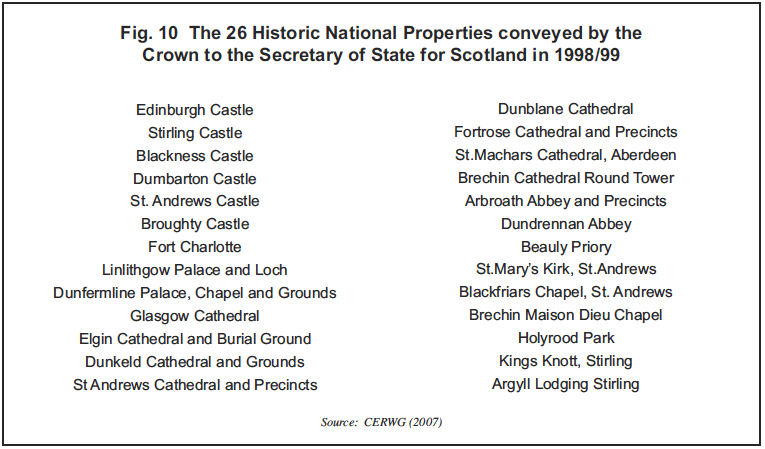The land of Scotland and the common good: report
The final report of the Land Reform Review Group.
Section 12 - Historic National Properties
1 Historically, the ownership of properties of particular national importance to Scotland as a sovereign country was retained by the Crown on behalf of the nation. Conspicuous examples include Edinburgh and Stirling Castles and the Royal Palaces at Holyrood, Linlithgow, Stirling and Falkland.
2 By the 19th century, the government in London was responsible for managing these Castles, Palaces and other iconic national properties held as ancient possessions by the Crown in Scotland. In some instances, the ownership was also conveyed to the government. This was the case with Holyrood Palace and as a result, the ownership of the Palace transferred from the Secretary of State for Scotland to Scottish Ministers at devolution under the Scotland Act 1998.
3 There was, in addition, a much larger transfer of historic national properties from the Crown to Scottish Ministers at devolution. In 1999, 26 properties held as ancient possessions by the Crown in Scotland were conveyed on behalf of the Crown by the Crown Estate Commissioners ( CEC) to the Secretary of State for Scotland. As a result, the ownership of these properties, listed in Fig. 10, transferred to Scottish Ministers under the 1998 Act.
4 The story of this transfer was first reported in the Crown Estate Review Working Group ( CERWG) Report in 2007, including the strange involvement of the CEC which had no prior involvement or responsibilities for the properties.1 The report also highlighted that two reservations were inserted by mistake by the CEC's lawyers into the titles now held by Scottish Ministers. The reservations are expressed in each title in the following terms:-
"under exception of and reserving to Her Majesty and her Successors the whole mines, minerals and fossils insofar as belonging to Her and Them within or under the subjects hereby disposed and free right to exercise all rights to which She or They may be presently entitled and all privileges which She or They may presently enjoy over the subjects hereby disponed". [2]
5 These reservations remain in the titles held by Scottish Ministers to these historic national properties. The Review Group considers this entirely inappropriate. The reservation of the mineral rights has created a situation where the CEC has ended up acquiring responsibility for these rights under 26 of Scotland's most iconic properties through the conveyancing, despite the fact that the CEC had no responsibility for these properties in the first place. The Group also understands that the second reservation appears to be incompetent as a reservation in Scots property law.
6 The Review Group recommends that the Scottish Government should ensure that the two reservations inserted by the Crown Estate Commissioners into the titles to Edinburgh Castle and other former Crown properties now owned by Scottish Ministers are removed.
7 While the CEC had had no responsibility for the Crown properties transferred in 1999, the CEC was responsible at the time of devolution for the management of two closely associated ancient possessions of the Crown in Scotland. One of these was 5 ha. in West Princes Street Gardens, including much of the slopes around Edinburgh Castle. The ownership of this area was conveyed in 2013 by the CEC to Edinburgh City Council, who already managed the area as part of Princes Street Gardens.
8 The other ancient Crown property managed by the CEC at the time of devolution was the King's Park at Stirling Castle and therefore an area of considerable national significance to Scotland. For over 900 years, this 140 ha. Park had been an ancient possession of the Crown and Scotland's foremost Royal Park as part of Stirling Castle. [3] In 2006, a dispute arose over the ownership and management of the Park, when the local community discovered that the CEC was negotiating to sell most of the ancient Park to a private company. In the end, the ownership of the King's Park was eventually conveyed to Scottish Ministers on behalf of the Crown by the CEC in 2013.
9 The Review Group considers that iconic national properties such as Edinburgh and Stirling Castles and other historic properties of equivalent national significance to Scotland, should be held inalienably on behalf of the people of Scotland by Scottish Ministers. The Group also considers that there should be greater clarity over the historic properties owned by Scottish Ministers. It might be useful to produce a list of those considered to be held inalienably on behalf of the nation. The list in Fig.10 might be considered to include examples of such properties, while Holyrood Palace is an example not in that list. The Group recognises that, while some properties could be obvious candidates for a national list, the 'bottom end' of the list would be more difficult to define. However, the Group considers that should not preclude drawing up a core list of Scotland's most significant historic national properties that should be held inalienably on behalf of the nation.
10 The Review Group's view is that the Scottish Ministers should establish this national list and that the recent introduction of the Historic Environment Bill into the Scottish Parliament, makes this an appropriate time to consider such a list. [4] This Bill involves the merger of the two bodies most involved in the management of Scotland's iconic historic properties, Historic Scotland and the Royal Commission for Ancient and Historic Monuments in Scotland.
Contact
There is a problem
Thanks for your feedback
